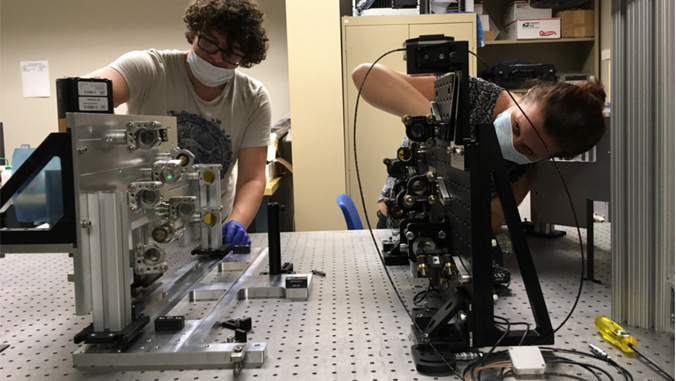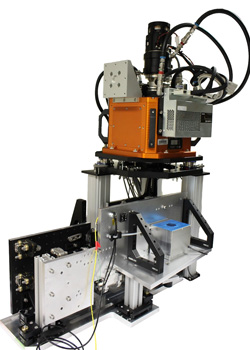
An innovative new instrument built by a team at the University of Hawaiʻi Institute for Astronomy (IfA), Caltech and W.M. Keck Observatory provides adaptive optics (AO) correction using objects invisible to the naked eye. The AO system recently deployed on Keck includes an innovative infrared pyramid wavefront sensor that can detect exoplanets and young dwarf stars where planet formation commonly occurs.
“It’s like adding night-vision goggles to Keck’s AO system,” said former UH postdoctoral researcher Charlotte Bond, an AO scientist who led the project development team at IfA’s Hilo facility. “The infrared pyramid wavefront sensor is especially suited for studying baby exoplanets, which are expected to orbit cooler, redder stars or be shrouded in dust, making them faint in visible light but relatively bright in the infrared.”
The paper detailing the project is published in the Journal of Astronomical Telescopes, Instruments, and Systems. In August 2020, Keck Observatory used the new AO system for regular science observations. Astronomers can now take images with more exquisite detail than ever before. This advanced AO capability will be used to deepen knowledge of planetary formation, dark matter and dark energy, and aid in the hunt for habitable exoplanets.
- Related UH News story: Maunakea telescope finds hints of life on Venus, September 14, 2020
AO technology removes the blurring effect caused by turbulence in the Earth’s atmosphere, resulting in sharper views of the universe. This technique relies on a star near the object of interest as a reference point; the wavefront sensor measures the atmospheric blurring of the starlight, then a deformable mirror shapeshifts 1,000 times per second to correct the distortions.
The new pyramid wavefront sensor is highly-sensitive; it uses a four-sided pyramid prism to split the incoming starlight and produce four images of the telescope’s primary mirror on a detector placed behind the prism. The distribution of light between the four images provides superior accuracy in measuring atmospheric blurring.

“This is the first infrared pyramid wavefront sensor available for scientific use. Most observatories use visible-light wavefront sensors,” said Peter Wizinowich, chief of technical development at Keck Observatory and principal investigator for this project.
The IfA provided the infrared camera for the sensor, which is based on new technology: very low noise, avalanche photodiode arrays. The project was supported by the National Science Foundation’s Advanced Technologies and Instrumentation program.
“This is a great example of how the technology development being done at the Institute for Astronomy enables new science on the telescopes in Hawaiʻi,” explained UH astronomer Mark Chun, who helped oversee the effort at IfA. “This project combined three areas of expertise at UH: near-infrared detectors, adaptive optics and education of the next generation of leaders in the field. It’s the latest in a long line of instruments developed at the IfA for telescopes on Maunakea, and is our first for the Keck Observatory.”
The success of the Keck II telescope AO upgrade was most recently demonstrated earlier this year in a study led by Jason Wang, a Heising-Simons Foundation 51 Pegasi b Fellow at Caltech, which tested the new technology and captured remarkable direct images of the birth of a pair of planets orbiting the star PDS 70. Chun and fellow UH astronomers Michael Liu and Jonathan Williams co-authored the study. During the testing phase throughout the past year, the upgrade was also used to study a nearby binary star whose past orbit was the closest known flyby to our solar system.
“UH astronomers have used the exceptionally sharp images from Keck AO to study the universe in entirely new ways over the past two decades. This new instrument will open the door to even more remarkable findings about our cosmic origins, especially about the big mysteries about how and when planets form,” said Liu.
“Astronomy progresses through technological advances. With this new camera which corrects image distortions at long wavelengths, we can now search for planets around the youngest stars and learn about their formation,” said Williams, an astronomer at IfA.

